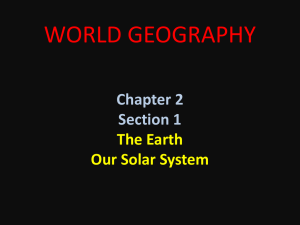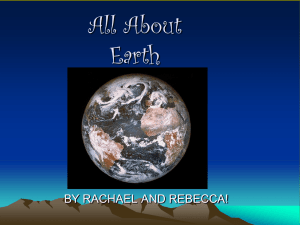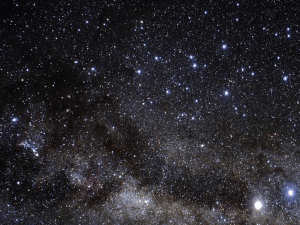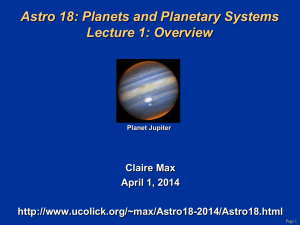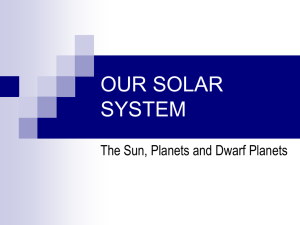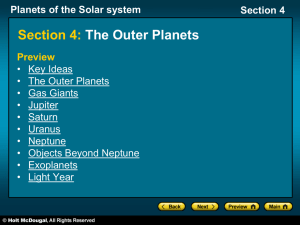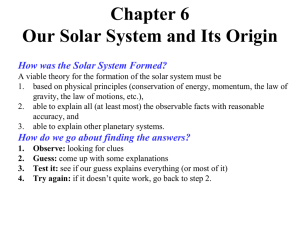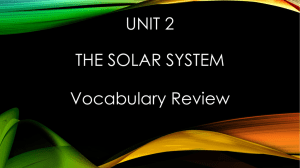Scale Model of the Solar System
advertisement
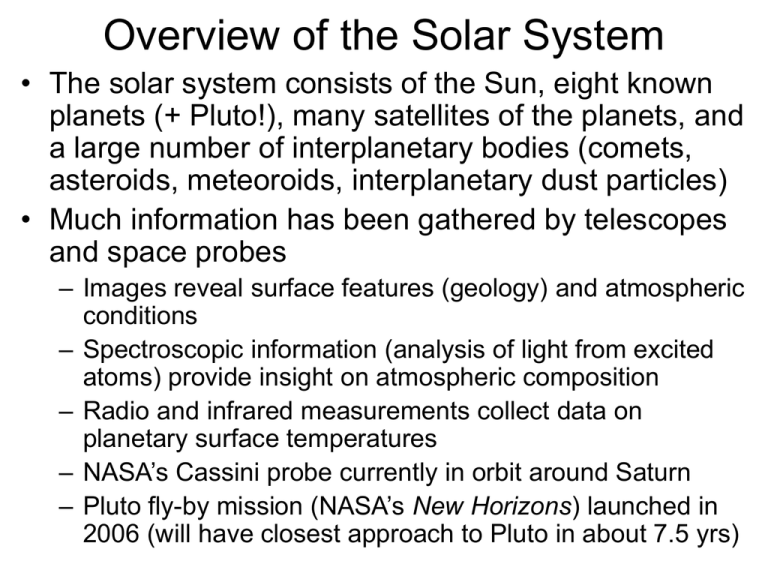
Overview of the Solar System • The solar system consists of the Sun, eight known planets (+ Pluto!), many satellites of the planets, and a large number of interplanetary bodies (comets, asteroids, meteoroids, interplanetary dust particles) • Much information has been gathered by telescopes and space probes – Images reveal surface features (geology) and atmospheric conditions – Spectroscopic information (analysis of light from excited atoms) provide insight on atmospheric composition – Radio and infrared measurements collect data on planetary surface temperatures – NASA’s Cassini probe currently in orbit around Saturn – Pluto fly-by mission (NASA’s New Horizons) launched in 2006 (will have closest approach to Pluto in about 7.5 yrs) Overview of the Solar System • The solar system has an overall disk-like structure – The orbital planes of most planets are closely aligned with each other – The orbits of most planets are ellipses with small eccentricities (nearly circular) • All planetary orbits, and virtually all satellite orbits, revolve in the same direction – Counterclockwise as seen from above the north pole • The direction of rotation for nearly all planets and satellites is in the same sense as the orbital motions – Exceptions are Venus, Uranus, and Pluto – Planetary Orbits (inner planets) www.nineplanets.org (outer planets) Overview of the Solar System • Terrestrial planets: Mercury, Venus, Earth, Mars – – – – – – 4 innermost planets Relatively small and dense with rocky surfaces Average densities range from 3.5 – 5.5 g/cm3 Small abundance of light gases such as H and He High abundance of metals and rocky materials Few or no satellites • Giant planets/gas giants/Jovian planets: Jupiter, Saturn, Uranus, Neptune – – – – Large outer planets Low density, no solid surface Average densities range from 0.7 – 1.7 g/cm3 Light gases (like H and He) are prolific (similar to Sun and stars) – Many satellites and ring systems The Planets • Overview of the planets and Sun (not to scale): Pluto Sun Mars Neptune Earth Mercury Venus Uranus Jupiter Saturn Relative Sizes of the Planets • Picture of the Sun and the planets, made to scale: (courtesy of Calvin J. Hamilton) Scale Model of the Solar System • Distance scales are used frequently on maps – i.e. 1 inch = 10 miles • Consider a scale model of the solar system where 1 inch = 1 million miles – Diameter of Sun = 860,000 miles ≈ 1 million miles = 1 inch on this scale (size of golf ball or ping pong ball) – See next slide for table of average distance of each planet from Sun, including distances using this scale model – The planets out to Mars are much more closely spaced than are Jupiter and the planets beyond it – Solar system is almost entirely empty space – Nearest star (Proxima Centauri) would be about 400 miles away on this scale • Approximately the distance from Columbus to Philadelphia Scale Model of the Solar System (1 inch = 1 million miles) Planet True Distance (million miles) Scaled Distance (feet) Scaled Distance (yards) Suggested Rounding Mercury 35.6 2.98 0.993 3 feet Venus 66.8 5.57 1.86 5 feet 6 in. Earth 92.4 7.70 2.57 8 feet Mars 141 11.7 3.91 12 feet Jupiter 481 40.1 13.3 13 yards Saturn 881 73.5 24.5 25 yards Uranus 1770 148 49.2 50 yards Neptune 2780 231 77.2 75 yards Pluto 3640 304 101 100 yards Scale Model of the Solar System • Other distances on the scale of 1 inch = 1 million miles: – Earth – Moon orbital diameter: about ½ inch – Diameter of Jupiter: about 1/10 of an inch (2.5 mm) – Diameter of Earth: 1/100 of an inch (0.25 mm) • Not realistic to represent planet sizes with this scaling • Another alternative scale: 1 foot = 1 million miles – – – – – – Sun = 1 foot across (basketball size) Jupiter and Saturn = 1 inch across (golf ball size) Uranus and Neptune = ¼ inch across (large peas) Earth and Venus = 1/10 inch across (mustard seed) Mercury = 1/3 size of Earth, Mars = ½ size of Earth Nearest star would be 4000 miles away Theory of Solar System Formation • Catastrophic theories – Solar system formed as the result of a singular cataclysmic event caused by external forces – In this view, planetary systems are rare • Evolutionary theories – Solar system was the result of natural internal processes accompanying the formation of the Sun – In this view, planetary systems orbiting other stars would be common • Themes from both models are used today – Overall process of planet formation is thought to be evolutionary, and planetary systems are predicted to be common – Many details of formation are thought to be the result of singular, catastrophic events Theory of Solar System Formation • Solar system is believed to have originated from a rotating, condensing cloud of interstellar gas and dust • The cloud then collapsed under its own gravity – Localized regions of high density formed (?) – Blast wave from exploding star caused compression (?) – As cloud collapsed, it flattened into a disk because of its rotation (“solar nebula”) • As the cloud collapsed, the compression was most rapid at the center – Central concentration became dense enough to form molecular hydrogen, and heating occurred (cooling slowed by molecular hydrogen) – Further gravitational collapse slowed by gas pressure – Temperature increased enough for nuclear fusion to occur – Process took about 100 million years (beginning of Sun) Theory of Solar System Formation • Material from the solar nebula was still condensing slowly after Sun was formed • Gradually, the gas in the nebula began to condense into planetesimals through process called accretion – Temperature highest in the inner regions of the nebula (radiation from Sun) • Prevented light gases from condensing into solid form • Heavier elements still condensed into solids • Inner concentrations were smaller as a result – Temperature was much cooler in the outer regions • All elements condensed and incorporated • Outer concentrations were thus larger • Larger concentrations attracted more matter through gravity, including that which formed disks around them (giving rise to moons and rings) – Collisions between planetesimals formed larger bodies (giving rise to planets) Theory of Solar System Formation • Other, later, collisions thought to cause some irregularities – Late collisions between planetesimals thought to cause unusual tilts of Venus, Uranus, and possibly Pluto – Formation of the Moon is thought to be the result of a collision between Earth and a very large planetesimal – Mercury may have lost much of its outer portion due to a collision – Many craters are visible on planets and satellites resulting from collisions with leftover debris in young solar system • Some planetesimals did not help form planets – Tidal forces exerted by young Jupiter formed asteroids between Jupiter and Mars – Pluto is thought of as a planetesimal that was never included into one of the larger planets – More minor planetary bodies are thought to be in Kuiper belt disk that exists from beyond Uranus to 50 AU from Sun (source of comets) – Oort cloud exists at 100,000 AU (another source of comets) • Solar system is thought to be about 5 billion years old Planetology • Planetology is the comparative study of Earth and the other planets – Several general processes and principles apply to all planets – All planets began from same material, but various processes have defined and altered their individual characteristics • For example, relative amount of atmosphere on each planet (and the Moon) can be understood in terms of a common “kinetic theory” of gases • Another example: amount of volcanic activity – Understood in terms of common theory on heat transfer and cooling mechanisms inside planets • By comparing information from other planets to that from Earth, we learn more about Earth as well Internal Structures of Planets • Differentiation causes relatively heavy elements to sink toward the center of each planet – Requires a fluid medium – Differentiation in terrestrial planets has helped to create a layered structure • Thin outer crust • Intermediate-density (semi-rigid) mantle • Dense nickel-iron core (which is partially fluid in some cases) – Differentiation in gas giants has created a small, solid core beneath fluid layers that make up most of the interior • Internal circulation, driven by planetary rotation, occurs in any planet that has fluid zones in its interior – Occurs in the core of the terrestrial planets (if at all) – Complex in interiors of the gas giants Internal Structures of Planets • Magnetic fields and particle belts are manifestations of internal circulation – Internal fluid motions in a planet can create electrical currents – Electrical currents create a magnetic field – Fluid motions in Earth’s nickel-iron core have created a significant magnetic field – Mercury has weak magnetic field despite a slow rotation – thus it probably has a large, partially molten core – All of the gas giants have intense magnetic fields due to internal circulation – A planetary magnetic field can trap electrically charged particles in belts or zones surrounding the planet Surface features of Terrestrial Planets • Slow-flowing motions in the mantle are responsible for tectonic activity (movement of crustal plates) – Associated with earthquakes and volcanic activity – Flows in the mantle may be caused by convection (overturning motion caused by heated bubbles rising in a gravitationally confined fluid) – On Earth, tectonic activity causes continental drift – On Venus, crustal plates are locked together (no drifting) – Tectonic activity is responsible for major structures of the crusts of terrestrial planets (mountains, continental distributions) • Several conditions influence surface geology – Composition of crust determined by original composition of the planet (after differentiation) and volcanism – Erosion by groundwater – Collisions with other bodies in space Planetary Atmospheres • A balance between gains and losses of various constituents controls atmospheric composition – Gains • Accretion of gases during and after planetary formation • Venting of gases from the interior • Chemical and biological processes that occur on the surface – Losses • Escape of gases into space (determined by mass of atoms/molecules and temperature of the atmosphere) • Chemical and biological reactions at the surface • Similar factors in all planets control the circulation of an atmosphere – Convection creates high- and low-pressure zones and vertical flowing motions – Planetary rotation converts simple convective flows into rotary flow systems (creates both calm and stormy weather)

